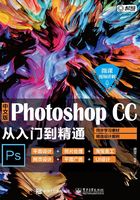
同步训练
实例1:制作飞出屏幕的特效

本实例将制作一个海豚飞出电视屏幕的特效图像,主要用到的功能和工具有魔棒工具、磁性套索工具、存储选区、移动选区和清除选区等。通过本实例,可以熟悉选区的相关操作。
实例效果

步骤1 打开“电视.jpg”素材文件,选择魔棒工具 ,在属性栏中设置容差值为“30”,然后按住“Shift”键不放,依次单击显示器屏幕区域,将整个屏幕选中。
,在属性栏中设置容差值为“30”,然后按住“Shift”键不放,依次单击显示器屏幕区域,将整个屏幕选中。
步骤2 执行“选择”→“存储选区”菜单命令,弹出“存储选区”对话框,在“名称”栏为选区命名,然后单击“确定”按钮。


步骤3 打开“海豚.jpg”素材文件,使用移动工具 ,将整个图像拖放至“电视”文档中(图层1)。
,将整个图像拖放至“电视”文档中(图层1)。
步骤4 选择磁性套索工具 ,在海豚图像边缘上单击鼠标左键,然后沿着海豚轮廓绘制闭合选区。
,在海豚图像边缘上单击鼠标左键,然后沿着海豚轮廓绘制闭合选区。


步骤5 在图层面板中选中“图层1”,按下“Ctrl+J”组合键,将上述选区创建为新图层(图层2)。

知识加油站
在“图层”面板中单击各个图层中的眼睛图标可以隐藏或显示图层,从而查看各个图层中的图像内容。
步骤6 选中“背景”图层,执行“选择”→“载入选区”菜单命令,在弹出的“载入选区”对话框中单击“确定”按钮,载入之前创建的屏幕选区。

步骤7 单击“选择”→“反向”菜单命令,将选区反向,选中屏幕以外的区域。

步骤8 选中“图层1”图层,按下“Delete”键,删除选区内的图像,取消选区后得到的最终效果如下图所示。

实例2:绘制甲壳虫

本实例将使用多种选区工具绘制甲壳虫形状,然后使用填充工具对各个选区进行填充,从而完成甲壳虫的绘制。通过本实例,可以更加熟悉选区的相关操作。
实例效果

步骤1 单击“文件”→“新建”菜单命令,在弹出的“新建”对话框中设置“名称”为“甲壳虫”,“宽度”和“高度”均为1000像素,“分辨率”为“300像素/英寸”,然后单击“确定”按钮。

步骤2 选择椭圆选框工具 ,在图像窗口中创建一个椭圆选区。
,在图像窗口中创建一个椭圆选区。

步骤3 单击工具箱中的“设置前景色”图标,在弹出的“拾色器”对话框中设置“R:183,G:170,B:0”,然后单击“确定”按钮。使用同样的方法,设置背景色为“R:255,G:247,B:153”。

步骤4 选择渐变工具 ,在其属性栏中单击“颜色条”图标
,在其属性栏中单击“颜色条”图标 ,在弹出的对话框中选择“基础”组中的“前景色到背景色渐变”选项,然后单击“确定”按钮。
,在弹出的对话框中选择“基础”组中的“前景色到背景色渐变”选项,然后单击“确定”按钮。

步骤5 单击属性栏中的“径向渐变”按钮 ,然后将鼠标指针移动到选区内,按住鼠标左键不放并拖动,即可填充选区。
,然后将鼠标指针移动到选区内,按住鼠标左键不放并拖动,即可填充选区。

步骤6 选择矩形选框工具 ,在其属性栏中单击“与选区交叉”按钮
,在其属性栏中单击“与选区交叉”按钮 ,然后在椭圆选区上创建一个矩形选区。
,然后在椭圆选区上创建一个矩形选区。

步骤7 设置前景色为黑色,按下“Alt+Delete”组合键填充选区,然后按下“Ctrl+D”组合键取消选区。

步骤8 选择单行选框工具 ,在黑色图像的下面单击鼠标左键,创建一个单行选区并将其填充为白色,再创建一个单列选区,并填充为黑色。
,在黑色图像的下面单击鼠标左键,创建一个单行选区并将其填充为白色,再创建一个单列选区,并填充为黑色。

步骤9 选择椭圆选框工具 ,创建一个椭圆选区并使用黑色填充。
,创建一个椭圆选区并使用黑色填充。

步骤10 选择移动工具 ,然后按住“Alt”键拖动黑色椭圆选区进行复制,然后按下“Ctrl+T”组合键变换形状,将椭圆旋转一定的角度。
,然后按住“Alt”键拖动黑色椭圆选区进行复制,然后按下“Ctrl+T”组合键变换形状,将椭圆旋转一定的角度。

步骤11 连续复制并调整多个椭圆,然后选择椭圆选框工具 ,在图像中创建椭圆选区。
,在图像中创建椭圆选区。

步骤12 设置前景色为白色,然后选择渐变工具 ,单击属性栏中的“颜色块”图标,在弹出的“渐变编辑器”对话框中设置从白色到透明的渐变,然后单击“确定”按钮。
,单击属性栏中的“颜色块”图标,在弹出的“渐变编辑器”对话框中设置从白色到透明的渐变,然后单击“确定”按钮。

步骤13 单击属性栏中的“线性渐变”按钮 ,在图像中按住鼠标左键不放并拖动,即可填充选区,然后按下“Ctrl+D”组合键取消选区。
,在图像中按住鼠标左键不放并拖动,即可填充选区,然后按下“Ctrl+D”组合键取消选区。

步骤14 选择矩形选框工具 ,创建矩形选区并填充为黑色。
,创建矩形选区并填充为黑色。

步骤15 执行“编辑”→“变换”→“变形”命令,对矩形选区进行变形操作。

步骤16 在按“Ctrl”键的同时单击鼠标并拖动复制矩形,执行“编辑”→“变换”→“水平翻转”菜单命令,然后将两只触角摆放到合适的位置。

步骤17 选择椭圆选框工具 ,在触角顶端创建一个椭圆选区,填充黑色并复制移动到另一个触角上。
,在触角顶端创建一个椭圆选区,填充黑色并复制移动到另一个触角上。

步骤18 使用同样的方法在触角上绘制更小的椭圆选区,将其填充为白色并复制,完成后的最终效果如右下图所示。
